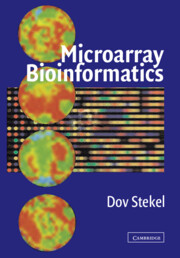Book contents
- Frontmatter
- Contents
- Foreword
- Preface
- Acknowledgments
- MICROARRAY BIOINFORMATICS
- 1 Microarrays: Making Them and Using Them
- 2 Sequence Databases for Microarrays
- 3 Computer Design of Oligonucleotide Probes
- 4 Image Processing
- 5 Normalisation
- 6 Measuring and Quantifying Microarray Variability
- 7 Analysis of Differentially Expressed Genes
- 8 Analysis of Relationships Between Genes, Tissues or Treatments
- 9 Classification of Tissues and Samples
- 10 Experimental Design
- 11 Data Standards, Storage and Sharing
- Appendix: MIAME Glossary
- Index
- Plate section
6 - Measuring and Quantifying Microarray Variability
Published online by Cambridge University Press: 15 January 2010
- Frontmatter
- Contents
- Foreword
- Preface
- Acknowledgments
- MICROARRAY BIOINFORMATICS
- 1 Microarrays: Making Them and Using Them
- 2 Sequence Databases for Microarrays
- 3 Computer Design of Oligonucleotide Probes
- 4 Image Processing
- 5 Normalisation
- 6 Measuring and Quantifying Microarray Variability
- 7 Analysis of Differentially Expressed Genes
- 8 Analysis of Relationships Between Genes, Tissues or Treatments
- 9 Classification of Tissues and Samples
- 10 Experimental Design
- 11 Data Standards, Storage and Sharing
- Appendix: MIAME Glossary
- Index
- Plate section
Summary
INTRODUCTION
Chapter 5 described a number of methods to correct for unwanted systematic variability either within an array or between different arrays. In this chapter, we describe methods to measure and quantify the random variabilities introduced by the microarray experiment. The common sources of variability (Figure 6.1) are
▪ The variability between replicate features on the same array
▪ The variability between two separately labelled samples hybridised to the same array
▪ The variability between samples hybridised to different arrays
▪ The variability between different individuals in a population hybridised to different arrays
Estimates of these variabilities are essential to gaining an understanding of how well the microarray platform you are using is performing. They are also important parameters for determining the number of replicates required for a microarray experiment – a topic that is discussed in full in Chapter 10.
The first two levels of variability – between replicate features or samples hybridised to the same array – are meaningful only for two-colour arrays.However, the second two levels of variability – between hybridisations to different arrays and between individuals in a population – are meaningful both for two-colour arrays and Affymetrix arrays.
MEASURING AND QUANTIFYING MICROARRAY VARIABILITY
The variabilities between different features on an array, between two samples hybridized to the same array or between samples hybridized to different arrays are all introducedby the microarray experimental process. In contrast, the variation between individuals in the population is independent of the microarray process itself. Experimental variability is measured with calibration experiments; population variability is measured with pilot studies.
Calibration Experiments
The aim of a calibration experimentis to identify and quantify the sources of variability in your microarray experimental platform.
- Type
- Chapter
- Information
- Microarray Bioinformatics , pp. 100 - 109Publisher: Cambridge University PressPrint publication year: 2003



